Doughboy MIA For November 2023: Second Lieutenant Chester Hinkley Kennedy
Published: 16 November 2023
By Peter Cash
Doughboy M.I.A.

Second Lieutenant Chester Hinkley Kennedy framed
Second Lieutenant Chester Hinkley Kennedy
A man is only missing if he is forgotten…
Our Doughboy MIA of the month is Second Lieutenant Chester Hinkley Kennedy, of the 1st Aero Squadron. Chester Kennedy was born November 25, 1895 in McMinnville, Tennessee to Clarence and Myra Hinkley Kennedy. After high school, he enrolled at the University of Tennessee, where he majored in Engineering. According to the Volunteer yearbook for 1917, his junior year, Chester was a vice-president of the Engineering Society and a member of the university’s Rifle Club.
Before the start of his senior year, Kennedy enlisted in the U.S. Army at Ft. Oglethorpe, Georgia. Sent to Ft. Sill, Oklahoma, he served with Battery B, 3rd Battalion, 6th Field Artillery. He received his commission on August 15, 1917. Kennedy later transferred to the Aviation Section, Signal Corps, and began training at Selfridge Field, Michigan, a center for aerial gunnery and photography training.
On July 8, 1918, 2nd Lieutenant Kennedy sailed for France aboard the liner America. Once in France, he continued his training at the 2nd Aviation Instruction Center in Tours. There, he would receive intensive instruction in aerial observation, gunnery, and radio. After several weeks of study, Chester Kennedy was finally ready to join an operational squadron.

1st Aero Squadron Salmson 2A2 over France, 1918.
On September 26, 1918, Kennedy officially joined the 1st Aero Squadron, then based at Remicourt. The 1st Aero Squadron was an observation unit, meaning that its primary missions were aerial reconnaissance, photography, artillery adjustment, and infantry liaison. The squadron was part of the 1st Corps Observation Group, composed of the 1st, 12th, and 50th Aero Squadrons. With the Meuse-Argonne Offensive just commencing, the squadron would be extremely busy.
Surviving records of the 1st Aero Squadron indicate that 2nd Lieutenant Kennedy flew his first operational mission on October 4, 1918. Three days later, on October 7, he was slightly wounded by ground fire while on an infantry contact mission between Fleville and the Bois de Romagne. Visibility was poor, and the pilot, Lieutenant Conrad Johnson, kept the aircraft’s altitude under 200 meters. Kennedy’s wound was not serious enough to prevent him from flying again on October 9. On the afternoon of October 10, Kennedy flew his first photography mission over Grand Pre. It was a complete success, with 33 of his 36 photographs good. He would go on to fly other missions on October 11, 18, two missions on October 21, and his final mission on October 23.
On the morning of October 23, 1918, Lieutenants Johnson and Kennedy took off for a photography mission. Their target was near the town of Buzancy, in the northern part of the Argonne sector. They never returned. Chester Kennedy’s brief combat career had spanned just 28 days, with barely 19 hours over the front lines.
One of the eyewitnesses to the crash of Johnson and Kennedy’s plane was 1st Lieutenant John A. Bensen, whose aircraft was flying as protection for the photographic craft. Here is his account, written in March, 1919:
On the morning of October 23, 1918, Lt. Kennedy (Observer) and Lt. Johnson were sent out on a Photographic Mission; I was sent out as protection for the mission and after crossing the lines, flying at about 3100 meters, the anti-aircraft fire grew very severe. I looked around and saw four burst directly below Lt. Johnson’s ship. He started down in a long glide for about 1500 meters, making two spiral turns and evidently in control. Then he fell into a vrille [spin] for about 500 meters, then into a straight nose dive, crashing head-on. I followed him down and was within about 600 meters of him when he crashed. The plane crashed in the vicinity of Chapignelle [sic] France. Their plane crashed on the north brow of a hill one kilometer due east of Chapignelle [sic], France. A search has been made for the location of the grave but without success, however, both pilot and observer must have been killed in the crash as the plane was a total wreck.
Another officer in the 1st Aero Squadron, 2nd Lieutenant Lee H. Rogers, apparently not a witness to the crash, reported in April, 1919 that “In hunting for these officers a couple of days later, certain officers of the first Aero Squadron found their graves, which were marked.” Nothing further in the surviving records indicates who those officers were, or how they knew that the graves were those of Johnson and Kennedy.
Based on Lt. Bensen’s testimony, Graves Registration Service personnel searched the area east of Champigneulle, especially the north slopes of several hills. They found neither graves nor aircraft wreckage. Then, in May, 1921 came the most promising lead in the case. Investigators had discovered that there were two officers buried in the same location where Lieutenants Johnson and Kennedy crashed. German forces had tentatively identified them as “B. Johnson” and “H.D. Arnott”. The investigators thought that “Arnott” could have been the Germans’ attempt at “Aeronaut”. Apparently, neither Johnson nor Kennedy were wearing identity discs, something fairly common at the time. American officers did not receive service numbers, so the discs would have been considered unnecessary. For investigators, the information was tantalizing, but not sufficient for positive identification. For that, dental records were necessary. Unfortunately, Kennedy’s mother was unable to locate any records of dental treatment, and he apparently had no dental work done while in the military.

Meuse-Argonne American Military Cemetery
In November, 1921, investigator Mary Hawkins requested that the remains in the two graves marked “Arnott, H.D.” and “Johnson B.” at the Meuse-Argonne American Military Cemetery at Romagne-sous-Montfaucon be disinterred to allow additional efforts at identification. Apparently, no action was taken on that request. To further complicate matters, Graves Registration Service correspondence from February 1922 shows that Arnott and Johnson were members of the British Royal Flying Corps. The last official correspondence regarding the case was in May, 1929, requesting that former Lieutenant Bensen be asked to provide additional information. No answer exists in the files.
Doughboy MIA has an Aviation Team dedicated to locating missing in action American Aviators of World War One. Lieutenant Kennedy’s MIA case is actively being researched by this team with the goal of finding and repatriating his remains. Until accomplished Second Lieutenant Chester Hinkley Kennedy is listed on the Tablets of the Missing, Meuse-Argonne American Military Cemetery
Would you like to be involved with solving the case of Second Lieutenant Chester Hinkley Kennedy, and all the other Americans still in MIA status from World War I? You can! Click here to make a tax-deductible donation to our non-profit organization today, and help us bring them home! Help us do the best job possible and give today, with our thanks. Remember: A man is only missing if he is forgotten.



